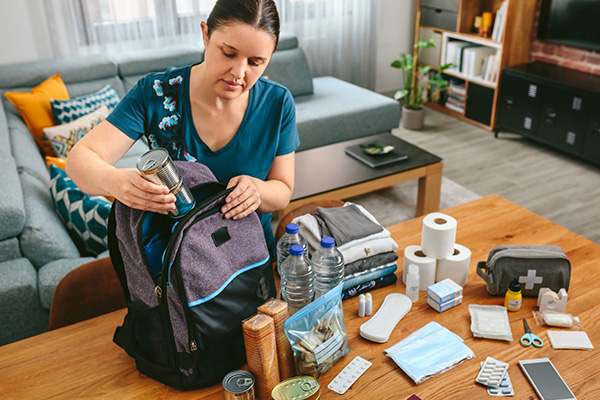

Home / Blog / Home Insurance / What Should Be In a Home Emergency Kit

The idea of having to navigate an emergency, such as a natural disaster like a flood or fire, is frightening. But being prepared can help to keep you safe just in case a disaster ever does occur. By building a home emergency kit, you can be prepared with the essentials you’ll need to survive extreme weather or a natural disaster.
Your home disaster kit should be designed so that it’s easy to grab and it’s always ready to go. Get a duffle bag or tote and keep the following items inside.
Free Home Insurance Comparison - Save up to 30%
No junk mail. No spam calls. Free quotes.
No Signup required
Start by packing enough food and water to last you and your pets several days. As a rule of thumb, each person should have one gallon of water available to them per day.
Canned goods can be a great choice since you can buy these in advance and they will last for years. However, make sure you have a manual can opener in your emergency kit, too.
If your family or pets are on any medications, it’s a good idea to keep extras on hand, if possible. You should add these medications into your home emergency kit.
Free Home Insurance Comparison - Save up to 30%
No junk mail. No spam calls. Free quotes.
No Signup required
Keep at least a couple of flashlights with extra, fresh batteries in the kit. Check them to make sure they’re still working.
A battery-powered radio can help you stay connected and receive important updates if your power and internet are out.
Having an extra cell phone battery and charger in your home emergency survival kit can be essential to your safety. If you know that severe weather is approaching, be sure to keep your phone fully charged.
Prepare essential documents ahead of time and keep them in a waterproof plastic envelope or other waterproof container. Include documents like your homeowner’s insurance and health insurance policies, bank account records, and Social Security cards. If you have pets, keep copies of their updated vaccine records, including their Rabies vaccines, since these may be required if you need temporary housing or if you need to board your pets.
You can either buy or build a first aid kit to add to your home disaster kit. Your first aid kit should include essentials like bandages, ointment, tweezers, disposable gloves, adhesive tape, alcohol wipes, disposable cold packs, and a first aid manual. Keep the kit stocked with some medications like pain relievers and antacids, but be sure to regularly check their expiration date and replace them as needed.
Stock your basic home emergency kit with some spare clothes for each family member. Include extra blankets and sleeping bags.
During a disaster, you may not have the option to use credit cards or even be able to access an ATM. Keep extra cash on hand.
Finish off your emergency kit with hygiene items, like soap, toilet paper, hand sanitizer, wet wipes, paper towels, and face masks for each family member.
Hopefully, you never have to use your home emergency kit, but keeping it stocked and at the ready can help you and your family to stay safe during an emergency.
Paige Cerulli Paige Cerulli is a freelance content writer and journalist who specializes in personal finance topics. She graduated from Westfield State University and brings more than a decade of professional writing experience to the ConsumerCoverage team. Paige’s work has appeared in outlets including USA Today, Business Insider, and more.